POS systems for bars should include tabs, drink inventory tracking, and more. I rated the best bar POS systems according to their prices, features, and more.
Finding a bar point-of-sale (POS) software can be challenging due to the specific requirements a bar setting imposes on this type of technology. Beyond just collecting orders and processing payments, the best POS system for bars offers the ability to pre-authorize tabs, collect tips efficiently, and accept payments in mobile and agile ways.
The systems in this guide provide modern, comprehensive, and efficient technology that allows you to serve great drinks while managing an excellent customer experience. Review my picks for the five best bar POS systems to find the best one for you.
| My score | Minimum monthly software fee | Contract length | Payment processing fees | |
| 4.55/5 | $0 | 2 years | From 2.49% + 15 cents | |
| Visit Toast | ||||
| 4.35/5 | $189 | 1 year | Varies by the processor, Lightspeed Payments: 2.6% + 10 cents | |
| Visit Lightspeed Restaurant | ||||
| 4.06/5 | $0 | Month-to-month | From 2.6% + 10 cents | |
| Visit Square for Restaurants | ||||
| 4.03/5 | Custom-quoted | 1 year | Custom-quoted | |
| Visit Lavu | ||||
| 3.96/5 | $69 | 1 year | Custom-quoted | |
| Visit TouchBistro | ||||

Pricing: 2.75/5
General features: 4.25/5
Niche bar features: 5/5
Ease of use: 5/5
Expert score: 5/5
Who should use it
Toast is a great POS for any bar setting, but it’s especially useful for busy bars with a lot of payment varieties. Additionally, bars that want rugged hardware and kitchen technology, such as an excellent kitchen display system (KDS), should consider Toast.
Why I picked it
Toast leads many of our guides, and for good reason. It continues to improve and offer an excellent POS product to all its users. It features niche tools, such as speedy bar screens and credit card pre-authorization. All of this great software is offered through Toast’s robust, rugged hardware, which is designed to withstand busy bar and tough kitchen environments.
While this system is my top pick due to its nearly all-encompassing bar POS features, it lacks payment processing flexibility, which can allow some bars to save money. Additionally, the two-year contract requirement can be a large commitment.
Monthly software fees:
Hardware costs:
Processing fees:
| Countertop Terminal Kit | Handheld Terminal Kit | KDS |
| Pay-as-you-go: $0 upfront; 3.09% + 15 cents processing fees Pay upfront: $1,024 + $69 per month | Pay-as-you-go: $0 upfront; 3.09% + 15 cents processing fees Pay upfront: $978.10 + $69 per month | Custom quoted |
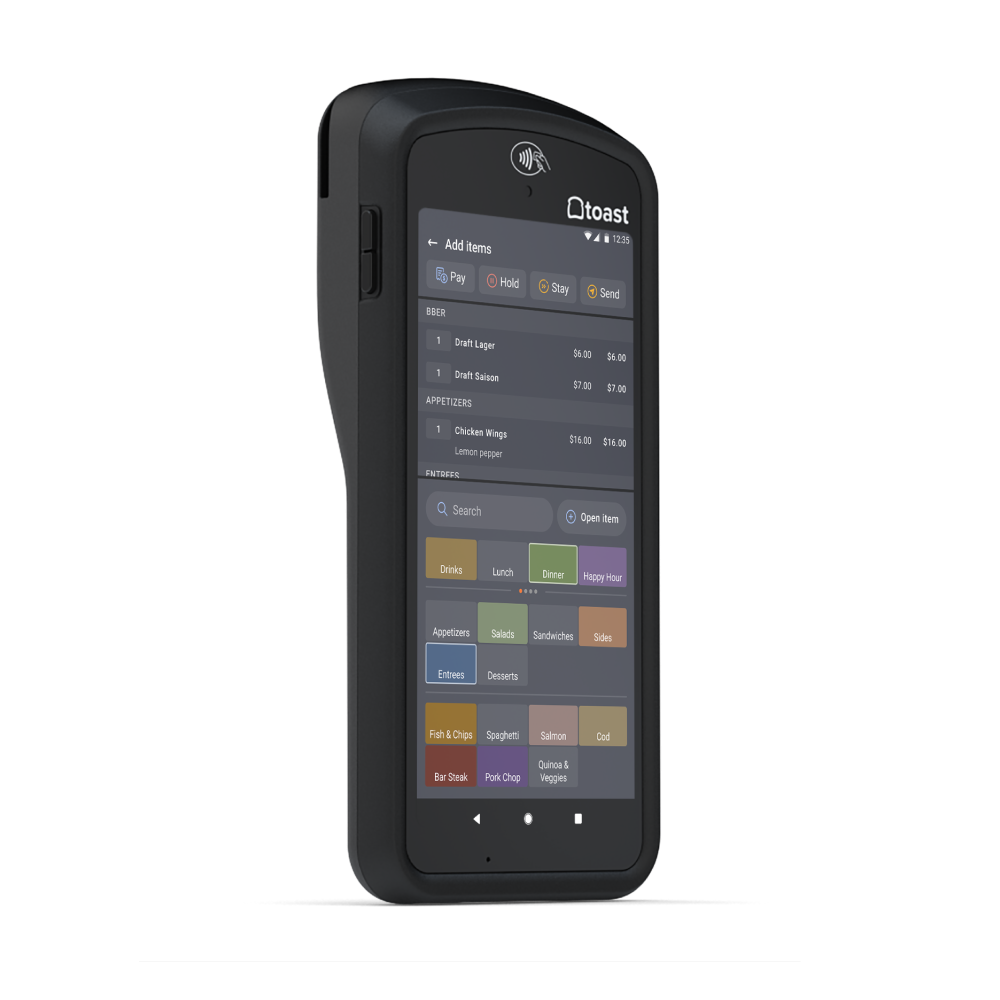

Pricing: 3/5
General features: 4.38/5
Niche bar features: 4.13/5
Ease of use: 5/5
Expert score: 4.75/5
Who should use it
Lightspeed Restaurant is ideal for busy bars that require extensive inventory tracking or those that want to customize their ordering screens.
Why I picked it
Lightspeed Restaurant offers excellent inventory management tools in its Essentials plan, which is now the software’s new base plan. This, paired with customizable order screens and single-seat floor plan management, makes it a great POS option for bars.
Lightspeed offers 24/7 support and multi-location solutions, and is used by top restaurant groups and bar programs, such as The Alinea Group and Cloverhill.
The system has all of the niche bar functions most bars need and excels in inventory management and tracking par levels. Because of how expensive stock can be, being able to track your inventory so closely is a big deal when owning or managing a bar.
However, I docked points from Lightspeed’s score because of its higher baseline subscription fees and limited tip management tools.
Monthly subscription plans*:
* Prices are lower for users who pay fees annually and enroll in Lightspeed Payments.
One-time installation fee: None
Payment processing: Lightspeed Payments starts at 2.6% + 10 cents for in-person payments.
| Terminal Kit | Verifone P400 | Mobile Case |
| iPad stand, cash drawer, receipt printer, and kitchen printer | Mobile, PIN-enabled tap, swipe, and dip card reader | Rugged handheld case for iPad |
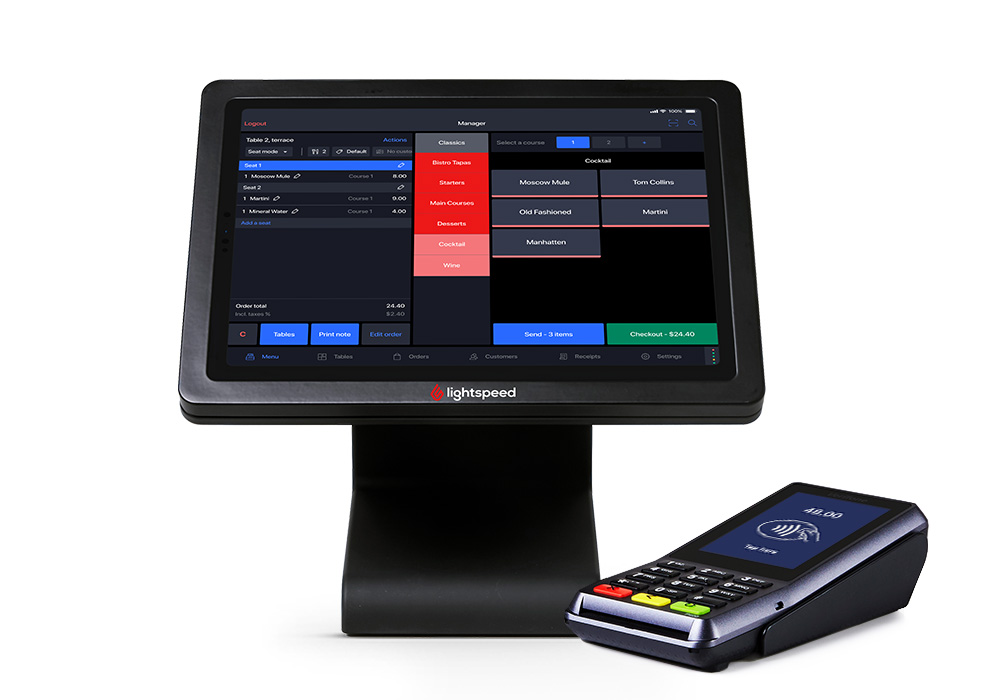

Pricing: 4/5
General features: 3.44/5
Niche bar features: 3.38/5
Ease of use: 4.63/5
Expert score: 4.75/5
Who should use it
Square is a great fit for low-cost, medium-traffic bars, new bars, or growing bars.
Why I picked it
Square for Restaurants is a low-cost option for bars. Its general POS system is an industry leader, striking a balance between extremely low costs and exceptional service features.
While Square for Restaurants may not be as robust for bars as others on the list, it’s very affordable and does not lock you into a contract. It offers enough features for bars to offer secure transactions. Square has a lot of promise, especially with its developing pre-authorization tool, and can be a great system for the right bar to utilize.
Monthly software costs:
Hardware costs:
Processing fees:
| Stand | Terminal | Stand Restaurant Station | Stand Mount |
| $149($14 per month for 12 months)* | $299($27 per month for 12 months) | $1,089* | $149($14 per month for 12 months)* |
| Payment-enabled iPad stand | Handheld order and payment terminal with integrated receipt printer | Complete POS including Square stand, cash drawer, and receipt printer | Counter or wall mount for POS or self-service kiosks |
*Price without an iPad; with an iPad, add $349.
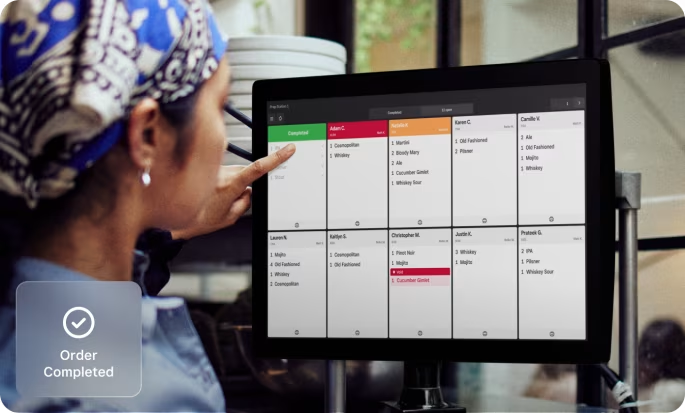

Pricing: 2.5/5
General features: 4.56/5
Niche bar features: 4.81/5
Ease of use: 3.88/5
Expert score: 4/5
Who should use it
Bars trying to offset credit card fees or those transitioning to credit card purchases should strongly consider Lavu for their bar POS system.
Why I picked it
Lavu is a great fit for bars that want the option to pass processing fees on to customers. If you’ve been operating as a cash-only operation, this can help you affordably expand to accepting card payments.
Lavu’s cash discount program enables this transition for bars without hurting them financially. This setting also helps offset credit card fees, which are typically a bar’s third-largest daily expense.
Overall, this system offers a solid user experience but lacks more in-depth tools.
Lavu’s hardware is iPad-based, so any additional hardware or card readers must be purchased separately.
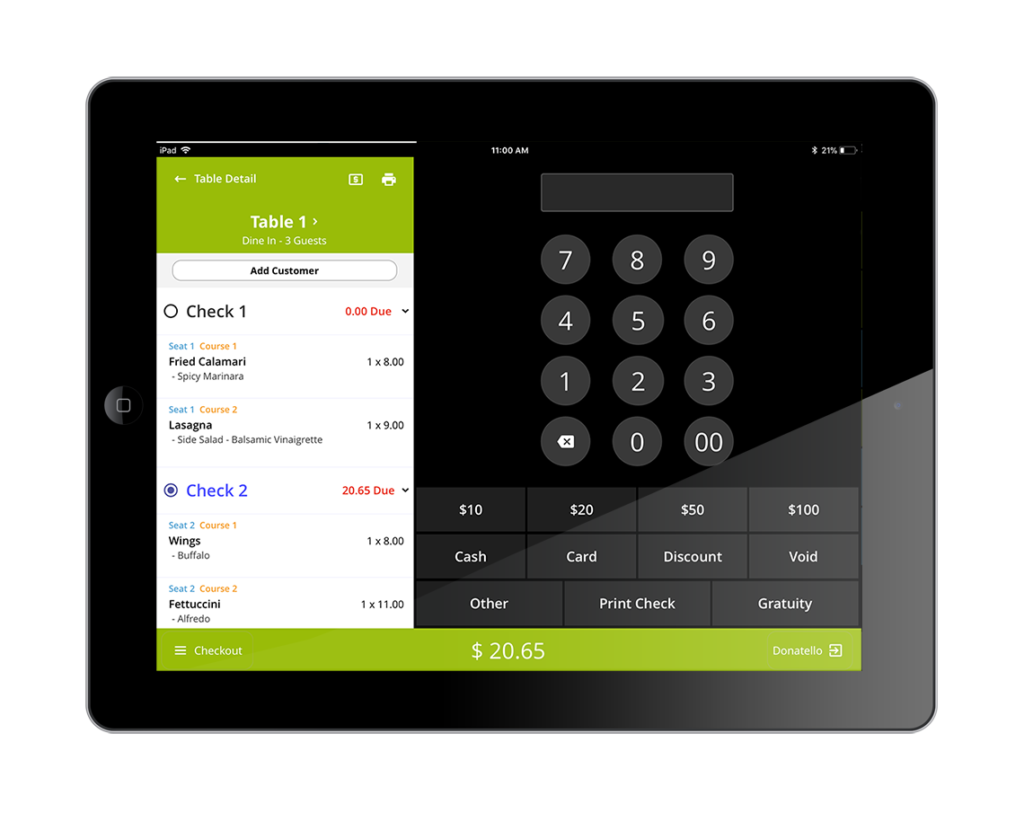

Pricing: 2.5/5
General features: 4.19/5
Niche bar features: 4.31/5
Ease of use: 4.25/5
Expert score: 4/5
Who should use it
TouchBistro is ideal for training new employees quickly, bars with multiple locations, or those with high employee turnover.
Why I picked it
TouchBistro is an iPad-native POS system that can be used in all bar types. Its interface is easy to use and offers great additional tools such as an extensive mobile reporting app and two-tap checkout. These tools, combined with familiar iOS-style software, enable efficient training for staff members.
The system lost points due to a lack of a free trial or plan, which may make it hard for some to commit to the service. Additionally, its add-on suite can get pricey if you want to experience all its features.
| iPad | iPad Terminal configuration |
| iPad used for TouchBistro’s software | Typical TouchBistro iPad terminal setup |
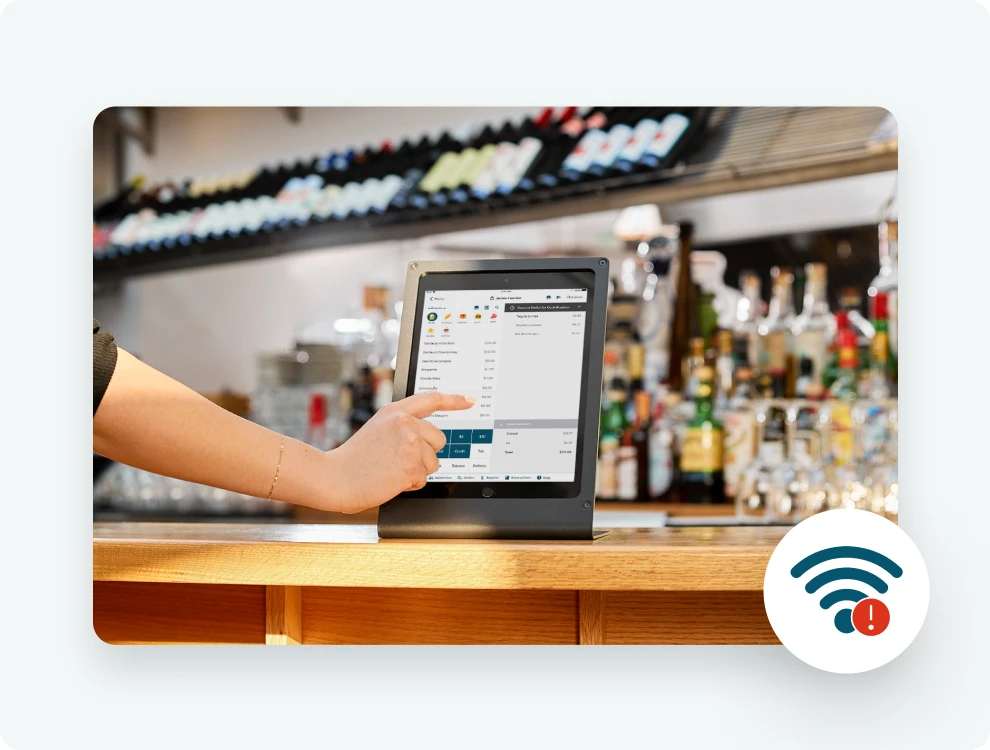
Most bar POS systems include general POS functions like payment processing, timekeeping, and loyalty, as well as many of these bar-specific functions.
Once you know your must-haves, set a budget. Most modern bar POS systems come with a monthly software fee and at least a small upfront fee for hardware and installation. It is important to look at your costs, revenue, and other financial figures with a prospective bar POS system’s cost built in.
This forecasting into finances with a bar POS system is key to understanding how much a month you can afford to pay, and which software is simply too expensive. The right bar POS for your business is invaluable, but if it is impossible to justify the cost of one software, then limiting your search to your budget and certain price points is the way to go.
With your budget requirements in mind, schedule demos of several POS systems. See how the interfaces work, and check out the speed screen functions. But more than that, get a feel for the customer support team. Do they seem like the people you want on the other end of the phone when you’re trying to troubleshoot a software glitch at 10 p.m. on a Saturday?
During your demo, ask these questions:
If you like the system during the demo, ask the sales representative if they can connect you with a few of their current customers so you can ask about their experiences. Ideally, these would be nearby bars that use this POS. The sales rep might need to get back to you with contact information, but it is not an unusual request.
In my experience, the best bar POS brands offer to connect you with some of their current customers without being asked. Contact these business owners and ask for their opinion of the software and support. Most will be eager to share their experience.
After a demo, the POS provider typically sends a full, itemized estimate of your expected costs for software, hardware, and payment processing (if the system includes a built-in processor). If the provider does not offer to do this, ask for an estimate directly. It is the best way to see exactly what your fees cover. Compare the estimates to find your best fit.
Estimates include more than just monthly costs. Remember to compare the terms and conditions of each contract as well. You don’t want to be surprised by lengthy contracts, installation fees, or high early termination fees.
Once you have made your final decision about which POS is best for your bar, contact the sales representative and begin the implementation process. It’s wise to take the time to notify the providers you opted not to work with.
This is a polite business move, and it will also save you time ducking calls and emails from sales representatives trying to close the deal. Furthermore, staying up to date on what other POS systems offer is always a good idea, especially if you are on the fence between a couple of choices.
I compared more than a dozen popular point-of-sale systems for bars based on what’s important to a variety of beverage operations, including bars, nightclubs, and pubs. Ease of use, niche bar functions, general POS functionality, and price were my main considerations. I also considered my personal evaluations of each software, alongside real-world user reviews.
Pricing is important, as it determines which software will fall into your budget. For pricing, I took note of any free plans offered, along with the type of hardware you can bring and the overall price of the subscription. I also looked at payment processing flexibility and the overall contract length required.
The general features I believe a POS system should have include inventory management, contactless payments, and the ability to manage employees in some way. Furthermore, offering a mobile reporting app, extensive reports on sales and business performance, and the opportunity to offer gift cards all played a role in this grading section.
The niche bar features I looked at were important due to how unique the bar setting can be. A big part of this grading relied on the ability to pre-authorize credit cards and ensure tipping could be collected fairly and accurately.
Additionally, cash management and handheld payments helped contribute to this score, as bars tend to receive payments in a variety of ways. Finally, the ability for fast bar screens and bar-specific integrations to be offered played a role in the final verdict.
Bars are busy, and bar POS systems do require some support to get right. Offering robust customer service and the ability to install or use the POS software offline in some capacity was a deciding factor in this section. Furthermore, the amount of training resources and whether or not the system was cloud-based helped determine the ease of use for these POS systems.
The final aspect of my decision in this guide was my overall expert score. This accounted for the features offered, the relative value of the software when compared to the subscription price, and how popular each system is in the industry. User reviews and how easy they claimed each system was to use also affected this part of the scoring.
Choosing a bar POS system is a fairly straightforward process, but you may still have questions. Finding out what entails searching for the best POS for a bar is important. These are the most common questions I get about the best bar point-of-sale systems.
The best POS system for bars, according to my guide, is Toast. Toast remains the best system due to its bar-specific features that come with the rugged hardware and excellent user interface that Toast has become known for. The industry is robust with options, but Toast’s POS software does all of the functions you need in a bar and does them at an extremely high level.
The Toast bar POS software ranks as my best bar POS software. This is due to robust software that helps speed up ordering, capture customer sales, and keep accuracy front and center when drinks are being made. Toast delivers speedy bar screens, excellent pre-authorization options, and plenty of employee/customer management tools that help bar owners grow their businesses while delivering a quality experience.
A bar POS system should offer niche functions such as credit card pre-authorizations, quick bar screens, and intuitive order building. These POS systems also need to offer flexible payment processing and cash management that accounts for the many ways customers may pay at a bar. A bar POS system focuses on accurate, speedy information input and agile ways to track and complete orders throughout a service.
Toast is one of the best POS systems on the market, and this is definitely the case for bars. With robust software design, rugged hardware, and excellent customer support, Toast is the ideal POS system for any bar.
A free baseline POS subscription, pre-authorization functionality, and speed order screens set Toast apart from the competition. With a variety of ways to take orders through its hardware and a dedication to order flow in its digital suite, Toast cements itself as the best bar POS offering on the market today.
Ray Delucci is a graduate of The Culinary Institute of America with a Bachelor’s in Food Business Management. He has experience managing restaurants in New York City, Houston, and Chicago. He is also the host of the Line Cook Thoughts Podcast, where he interviews and shares the stories of foodservice workers. Ray currently works in food manufacturing and food product development.
Property of TechnologyAdvice. © 2025 TechnologyAdvice. All Rights Reserved
Advertiser Disclosure: Some of the products that appear on this site are from companies from which TechnologyAdvice receives compensation. This compensation may impact how and where products appear on this site including, for example, the order in which they appear. TechnologyAdvice does not include all companies or all types of products available in the marketplace.